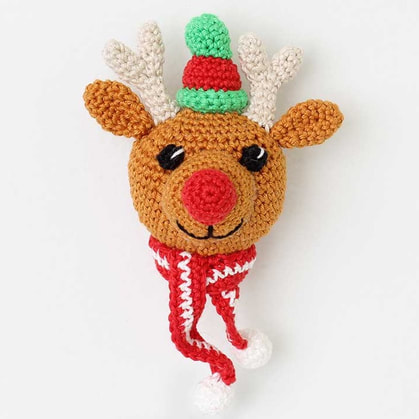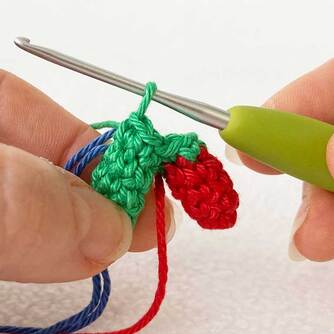Crochet Christmas Wreath
How to Join the Reindeer's Antlers
A quick tutorial on how to crochet the tops of the Reindeer's Antlers together.
Here's a recap of the pattern for making the parts of the Antler:
Here's a recap of the pattern for making the parts of the Antler:
Reindeer's Antlers - make 2
Each is made as two separate parts - Part A and Part B - from the top down and then joined together to make an antler. Do not stuff.
Part A
Rnd 1: With COL C, working into a magic ring, 6 dc. 6 sts
Rnds 2-4: Dc around.
Fasten off.
Part B
Work as Part A but do not fasten off at the end of Rnd 4. Continue on to Rnd 5 below to join the two parts together.
Rnd 5: 3 dc in Part B, then, starting in next unused stitch after last stitch of Rnd 4 on Part A, 6 dc, then, starting in next unused stitch on Part B, 3 dc. 12 sts.
Don't worry if there's a hole where the two parts join - this is normal and can be sewn closed using a length of COL C and a yarn needle once the antler is finished.
Rnd 6: 6 dc2tog. 6 sts
Rnds 7-10: Dc around.
Fasten off. Leave a long yarn tail to sew the Antler to the top of the Head once you've made all the parts.
Each is made as two separate parts - Part A and Part B - from the top down and then joined together to make an antler. Do not stuff.
Part A
Rnd 1: With COL C, working into a magic ring, 6 dc. 6 sts
Rnds 2-4: Dc around.
Fasten off.
Part B
Work as Part A but do not fasten off at the end of Rnd 4. Continue on to Rnd 5 below to join the two parts together.
Rnd 5: 3 dc in Part B, then, starting in next unused stitch after last stitch of Rnd 4 on Part A, 6 dc, then, starting in next unused stitch on Part B, 3 dc. 12 sts.
Don't worry if there's a hole where the two parts join - this is normal and can be sewn closed using a length of COL C and a yarn needle once the antler is finished.
Rnd 6: 6 dc2tog. 6 sts
Rnds 7-10: Dc around.
Fasten off. Leave a long yarn tail to sew the Antler to the top of the Head once you've made all the parts.
UK and US crochet terms are NOT the same - this is written in UK terms. If you're used to working in US crochet terms - substitute "sc" for "dc" in the pattern above.
Let's break that down step by step...
Before we begin... You'll be making all the parts of your Antler in a Beige yarn or something similar - I've made the tops of my Antler for this tutorial in 2 different colours so help you see which part I'm working into. Let's call the fastened off Red one Part A and the Green one - which is still attached to the ball of yarn - Part B. On both I've tucked the starting tail down inside the Antler out of the way. These are the parts you'll have just before you start Rnd 5.
|
The Blue thread in Fig 2 above is a stitch marker, showing the end of Rnd 4. The first instruction in Rnd 5 is "3 dc in Part B" so work those 3 UK dc (US sc) in Part B (Green) as if you were doing another ordinary round.
|
Next, pick up Part A (Red) and insert the hook into the next stitch after the last stitch of Part A's Rnd 4 - Fig 3.
|
|
Work a UK dc (US sc) into that stitch - Fig 4.
|
Carry on working 1 UK dc (US sc) in each stitch around the top of Part A (Red) - in Fig 5 above, I have worked the first 3 stitches and have another 3 to do - making a total of 6 stitches in the top of Part A.
|
|
Carry on with another UK dc (US sc) in each of the next two stitches to finish Rnd 5. You will have worked 3 stitches in Part B, followed by 6 stitches in Part A and another 3 stitches in Part B making a total of 12 stitches for Rnd 5 - Fig 8.
|
For the next round, Rnd 6, you need to work 6 decreases - that's 6 dc2tog (or 6 sc2tog in US terms). In Fig 9 above I've worked the first two decreases of Rnd 6.
|
|
At the end of Rnd 6 you'll be left with 6 stitches, you then dc around (US sc) for another four rounds (Rnds 7-10), creating the bottom part of the Antler. Fasten off at the end of Rnd 10 - Fig 10.
|
Fig 10 is looking down on the top of the Antler. Don't worry if there's a hole where the two parts join - this can happen, depending on your natural tension, it can easily be sewn closed with a length of the Antler yarn and a yarn needle.
|














